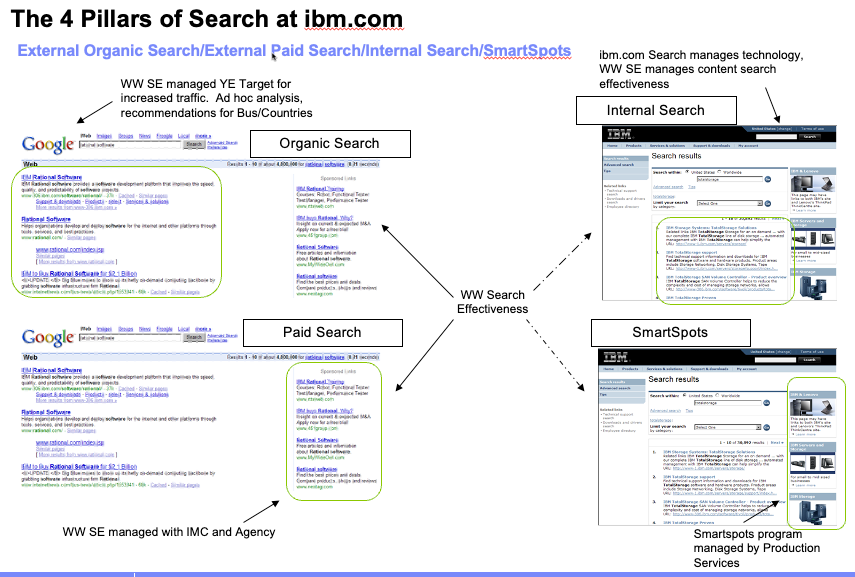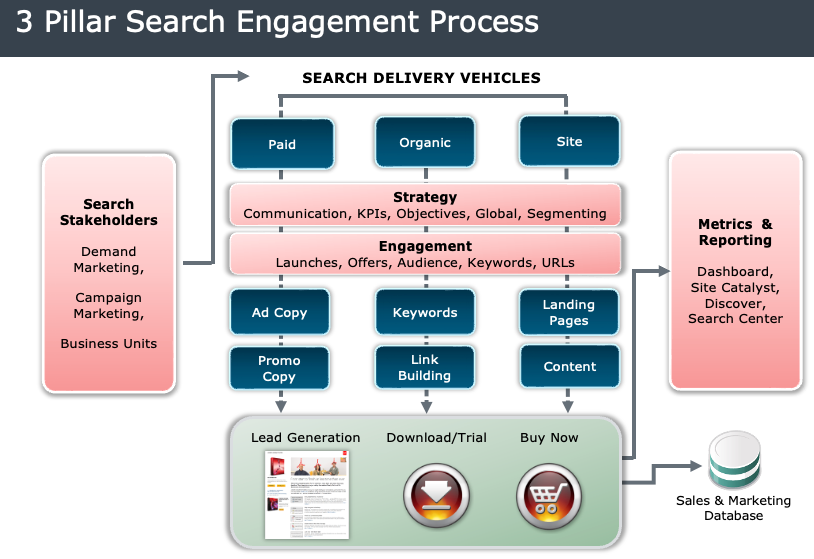The most significant value of search marketing comes from being findable no matter where a customer searches, but too often, we do not align any of the many silos that could benefit from integration. When a searcher is searching, they are not thinking about paid search or organic; they are trying to find a solution and want the best result. Beyond paid and organic, I see a lot of missed opportunities with site search and not leveraging content and data already available to make them all work in harmony.
This post came from two strategic discussions with companies without integration between the various search activities. In the first meeting, the manager complained that they would be less dependent on Google if their site search improved. The second was it took twenty emails to various people in the organization to get the following questions answered:
- What are our mission-critical keyword phrases?
- What phrases are we buying in paid search?
- What phrases are being worked on by the SEO team?
- What words are we tracking in social media?
- What are our top site search queries?
In both cases, the clients asked me to suggest better integration. Searching my PPT library, I came across a twenty-year-old presentation from my IBM days and another for Adobe. I had presented to executive management why and how we needed to integrate search. That meeting started a radical shift in how we managed Search at both organizations, leading to a significant increase in customer satisfaction, increased traffic, and significant cost savings in terms of time and budget.
The 4 Pillars of Search
The following are the 4 Pillars of Search defined 22 years ago at IBM. I was mandated to improve search performance, but different teams, agencies, and performance criteria managed all. The first step was to attempt to integrate them into a single management structure.

- Pillar 1 – Organic Search
- Pillar 2 – Paid Search
- Pillar 3 – Internal Site Search
- Pillar 4 – Smart Spots
Smarts spots was an interesting engagement method we developed at IBM to help fund the Search Team and to understand the interests of specific product searches. Since we controlled the site search, we could have internal ads in the search results. The most successful was for older model computer hardware searches. A search for an IBM T20 meant the searcher could want multiple options. We increase engagement and upsell opportunities by presenting an ad block encouraging upgrades or model-specific accessories. We charged brand teams a fee to have their product ad listed here. This might be where Google got the idea for AdSense, as they were very interested in how we did the matching, the conversion results, etc.
Traditional 3 Pillar Integration and Engagement Strategy
At Adobe, we helped integrate a similar strategy managed by the global search manager responsible for the performance of all three areas.

Benefits of Integrated Search Programs
In both organizations, the integration offered the same benefits, actions, and approaches to integrating search into a centrally managed solution. The following were my initial five action steps you can take that will improve performance and result in a more holistic approach to search.
Step 1: Reduce Redundant Effort
The first step is to try to identify and remove redundancy. This can be improved by sharing keyword lists and desired landing pages between disciplines using an extranet or keyword management software. This will reduce the total team’s workload and help understand the collaborative performance of all keyword phrases.
Keyword Research and Management – All four disciplines did separate and independent keyword research to determine the most popular phrases. It only needs to be done once and shared across the teams, integrating data from all pillars. Yes, everyone can enhance it, but share what has been done. This is highly effective if you use an AlwaysOn keyword strategy and have a lot of competing business areas. I wrote an article in 2012 describing the typical “Keyword Management Dysfunction” and how disorganized companies are. Even for site search, PR, and Social Media, this master list of keywords and their associated “Preferred Landing Page should be available to anyone working on the website. Sharing the words people search for on the site can help drive high-value conversations. In 2013, I wrote about how a company had identified $4.5 million in revenue through mining site search queries for opportunities.
Landing Pages and Content – Landing pages assigned to keywords are another critical item that should be shared. For example, many companies map keywords to specific “Preferred Landing Pages (PLP’s) that they want to rank in organic results. These can be shared with site search to add to the boost list to ensure the best page also ranks for critical terms in site search. The organic team can review paid search landing page performance and use high-converting ads as meta descriptions to help increase organic click rates. The paid team can point ads to PLPs relevant to a topic, increasing the page’s quality score and reducing per-click costs.
Keyword Cannibalization – The potential for keyword cannibalization is significant in large organizations with vertical industry and company-sized specialties—for example, rugged laptops. Companies may have more than a dozen verticals, from military to mining to construction, that can all use these laptops, and we’re always competing for a position in Google with other manufacturers and between these business units and the laptop teams. Ultimately, we made the case for a single primary page for this product with sub-pages on each vertical site section as an offer. By approaching strategically, we were able to create a single area of focus that we could get to rank and then allow searches to navigate to any unique attributes by vertical.
Step 2: Increasing SERP ShelfSpace
If we think of the search results page as a store shelf, the more space we occupy with compelling product packages, the greater our sales opportunities. The same is true in Search Marketing. The more compelling ads and ranked pages you have, the more opportunities for consideration you will have. Typically, these activities are all monitored separately, and we don’t know how they perform collaboratively. This challenge can be improved by tracking the search results page at a keyword level to understand if and how we are represented via paid, organic, and social media to ensure that we are represented and collaborative.
Step 3: Reducing Competing Messages
Not reviewing your SERP ShelfSpace opens you up to another huge problem—competing messages. These can come from different business units and be paid or organic. Too often, a niche offering discounts for students, seniors, or advanced users is seen by all searchers, prompting them to click and be disappointed they are omitted or try to get creative to benefit from the discount.
To prevent this, follow steps 1 and 2 to model your words to decide what you want people to see and do related to this phrase. If you can develop this matrix, you can set the business objective and the search intent, craft the best organic page, and set specific related offers and site links in paid. Just this simple discussion and prior planning can significantly increase clicks.
Step 4: Reducing Contextual Mix Match
Many companies also take their product search performance for granted. Few companies even know what appears in the different search forms when someone searches for a product name. Recently, a large company told me they never buy their product names in paid search since they rank #1 for all of them. This can be a good strategy only if you know what is represented in organic search. In their case, most of the products did rank well in organic search, but a few had PDFs or less than compelling snippets that needed to be paid to be utilized until they cleared it up. In other cases, paid is trying to sell, and organic well is organic, and you get what you get.
A classic example I have used is the query for a company’s software download page: “Webex Downloads.” I assume the searcher intends to find the download page so they can download the software. The paid team is using it to get them to subscribe to Webex. As this was the first reference to WebEx downloads, it was highly clicked but few conversions.
This is critical in site search, especially for technology and B2B companies. A site search for a product often returns support and news content more than product information. Site search engines are usually not as sophisticated as external engines. They frequently can’t index complex or highly creative pages, resulting in product home pages being absent from site search results. I am aware of one case where a site’s navigation structure was overly complicated, and 67% of the visitors to the home page went immediately into site search to find specific products. Unfortunately, most of the results on the search results page were support documents, increasing negative customer satisfaction responses and site abandonment.
This can easily be solved by understanding the optimal content for key phrases and simply boosting the home page or preferred landing page of products in site search. Since this is your search engine, you can influence the results and ensure the right mix of content for critical queries such as product searches. Again, no need to recreate the master list, it should be the same or very similar to what you are doing for paid and organic.
Step 5: Increasing New Product Engagement
The separation of tactics is the most acute for new products launched. With all the noise from social media, the time for integration in search is never more critical than for new product launches. Traditional advertising is great for introducing a product to the marketplace and generating interest, often leading to a search. Research from Google found that search traffic increased by 21% when the TV commercials matched paid search campaigns. In addition to the traffic increase, search visitors typically spend twice the time interacting with the site than those who did not search. Many don’t think about organic listings since they believe it takes too long to rank the pages. That is not always the case. Innovative companies are starting to launch “teaser pages” for the products to build links and create an organic presence in both organic and site searches.
A unified search initiative brought to the traditional and digital planning process reduces the moving parts. It ensures that you have all the bases covered and stand a better chance of being aligned to the other initiatives than you would doing each independently.
Conclusion and Next Steps
Having the key areas of Search Marketing Integrated and coupled with a Search Council to enable sharing and coordination. No matter which pillar or silo – the ultimate goal of Search Marketing is to match the right offer and content to the search’s query, but rarely do we manage it holistically. The lack of an integrated ecosystem creates challenges that result in missed opportunities, frustrated searchers, and redundant efforts.
If your organization wants to integrate your search programs, our team can help bridge the gap. We have helped dozens of enterprise companies streamline and integrate their programs, making them more effective and efficient. Starting with the variation of the framework above, we will work with your leadership to create a structured Answers Management framework that aligns with your business objectives. From establishing clear roles and processes to providing hands-on training and implementation support, we guide you each step of the way. Let’s transform your independent search programs from a cost center into a growth driver—contact us today to get started!
